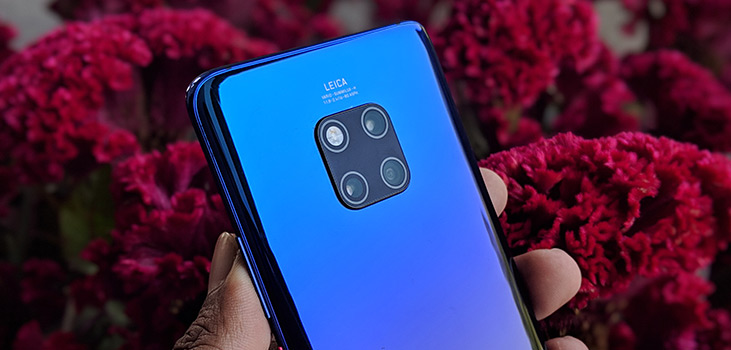It was in late 2018 that Huawei introduced its popular Mate series in India. The first phone in the series – Mate 20 Pro – is designed to inspire creativity and productivity, empowering users to express themselves, without being restricted to the limitations of a smartphone.
The phone inherits several physical design components from its counterparts such as three cameras on the back similar to the LG V40, each with a different focal length. Like the Vivo Nex, the Mate 20 Pro has an in-display fingerprint sensor. Similar to the iPhone X, the Mate 20 Pro has a 3D face unlock and, like Samsung’s Galaxy Note 9, an OLED display. The smartphone is powered by Huawei’s densest and highest performing system on chip (SoC) – Kirin 980. Manufactured with the advanced 7nm process, according to Huawei, the Kirin 980 SoC offers improved performance, better battery efficiency and a smoother user experience.
With the Mate 20 Pro, Huawei seems determined to fight the flagship battle with its competitors. Priced at Rs 69,990, the Mate 20 Pro sits comfortably on the stack of most premium smartphones. So, is it worth the money? Let’s find out.
Design
From the 7nm processor and faster LTE to the wireless charging, huge battery, waterproof design, in-display fingerprint scanner, 3D face unlock, high-resolution OLED display, multi-camera system and a massive RAM and storage, the Huawei Mate 20 Pro easily checks all the tick-boxes. While there’s no headphone jack, Huawei includes a dongle and a pair of USB-C-connected earphones in the box.
Despite the Mate 20 Pro being an expensive phone, earphones bundled are average. The Pixel USB-Type C earbuds and Galaxy Note 9 (with its AKG earphones) are, in fact, ahead of Huawei’s Mate 20 Pro. In direct competition with the Google Pixel 3, Samsung’s flagship phones and Apple iPhone XS Max, the 6.4-inch Mate 20 Pro is smaller in width – it is, however, larger than Pixel 3XL. The Galaxy Note 9, on the other hand, feels much more like a shrunken tablet.
With smooth glass finish, along with a subtle texture that Huawei calls Hyper Optical Patterns, the smartphone has an appealing look. The phone is no less slippery as compared to other glass phones, but during time with the phone, I never dropped the phone, not even once. The power button positioned below the volume bar on the right side helps in using this phone with single hand.
Display
When placed alongside the Galaxy Note 9, the Mate 20 Pro display matches the intensity of Samsung’s OLED display in terms of colours, brightness and sharpness. However, for me, Huawei display has an edge over the Samsung, thanks to the Natural Tone mode, which works similarly to Apple’s True Tone – it dynamically adjusts the white balance of the display to match the surrounding light for a more natural, paper-like viewing experience.
There is also a notch like the iPhone X series, and Huawei has a good reason for it. The company uses the same technique as Apple’s Face ID, only Huawei calls it 3D Face Unlock. The phone uses a combination of an IR sensor and over 30,000 invisible IR dots pushed through neural networks to create a mathematical model of your face, which is then sent to the secure enclave to confirm a match. It also adapts to the physical changes in your appearance over time. Huawei’s 3D Face Unlock works better than Samsung’s combination of iris and face recognition.
Performance and battery
Being one of the costly Android flagship phones right now, the Huawei Mate 20 Pro needs some justifications for its price . I think there are three – performance, camera and battery life.
After using the device for almost 15 days, I found that the Kirin 980 chip is superior to the Snapdragon 845, for it offers better responsiveness, quick app launches, zero camera delay and fluid gesture animations. You fill find many features that replicate the iOS user interface. One such feature is the multitasking tray and while you can criticise Huawei for it, I, for one, am really impressed by how close Huawei has come to truly imitating the smoothness of the iOS experience.
Then, there is the huge 4,200mAh battery not yet widely seen on smartphones nowadays. Two hours of constant gaming of PUBG cost me only 20 per cent of the battery, which clearly indicates that a longer gaming session is required to completely drain the battery. Huawei has done great work in terms of power optimisation, for try as I might, I couldn’t do anything to drain the battery quickly. Even if you have smartwatch connected to it for most of the time, just like I had the Fossil Q for a good number of working days, the battery just refuses to die. The phone can also wirelessly charge other compatible smartphones via reverse charging technology.

The smartphone comes with the world's first 40W HUAWEI Super Charger that can charge the phone’s long lasting 4200 mAh battery to 70 per cent in just 30 minutes. Also, given the longevity of large batteries, the Mate 20 Pro will enable the consumers to unleash their potential and live their lives to the fullest.
Joining LG and Samsung in the ‘more cameras are better’ notion, Huawei Mate 20 Pro packs three cameras at the rear. Huawei has equipped the Huawei Mate 20 Pro with a 16mm Leica ultrawide angle lens and killed the dedicated monochrome sensor seen in P20 Pro.

The Huawei Mate 20 Pro has a 40MP main camera, a 20MP ultra wide-angle camera and an 8MP telephoto camera. Together, the trio supports a wide range of focal lengths – equivalent to the performance of a 16 – 270mm zoom lens. And while the rear camera produces excellent photos – some of them far better in quality than the Pixel 3 – I still miss the great black-and-white photos that Huawei allowed users to capture with that dedicated sensor in the P20 Pro.
The ultra-wide lens, equivalent to a 16mm focal length, comes in handy to comfortably squeeze in more people and landscape. Consumers can also shoot in RAW format and can later process the image.
The 40MP sensor combines four neighbouring pixels into one to deliver a 10MP shot with enhanced detail. I compared it thoroughly against the Pixel 3XL and found that Huawei’s hardware has the right rhythm to offer a realistic photography experience. But what Google does with a single software driven camera in Pixel 3XL still amazes me. The Huawei Mate 20 Pro’s photos, just like the Pixel 3XL, are crisp and sharp.


If you disable the Huawei’s Master AI processing, the Mate 20 Pro’s camera captures more noise than the Pixel 3 XL. The 24MP selfie camera on the Mate 20 Pro produces unrealistic photos, which lack in detail.
Conclusion
With the Mate 20 Pro, Huawei has easily succeeded in beating many flagship smartphones available on the market today. The Mate 20 Pro has a rich camera, fast performance, faster 3D face unlock and an appealing OLED display. The Mate 20 Pro, however, is expensive. But once its price reduces to something more attainable, it’ll become a real contender in the premium space, which is currently ruled by Apple and Samsung.
Pros
Design, OLED display, long battery life, camera
Cons
Price, UI
